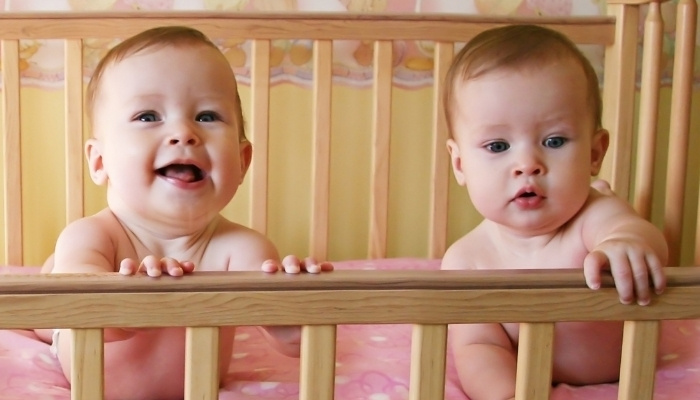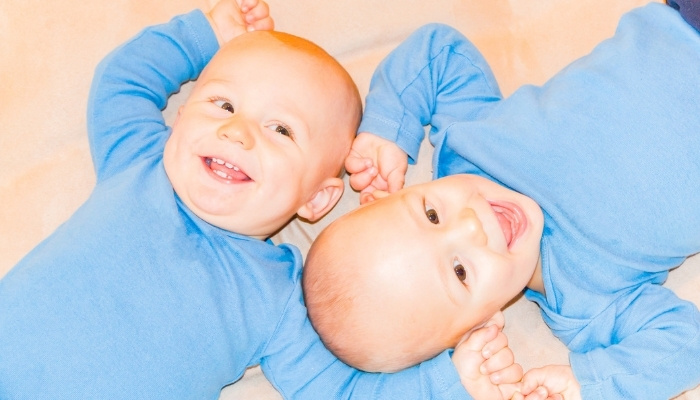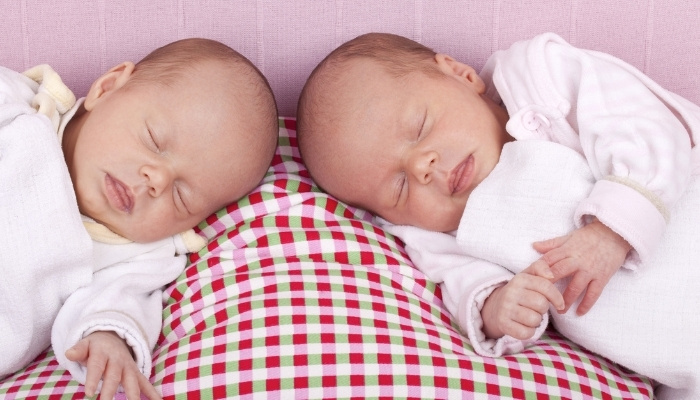If you are a mother of twins or expecting twins, you are likely familiar with the fact (or should start getting ready) that you usually become the center of attention when you go out with your two little ones in public.
People are so fascinated with twins! The phenomenon of having two babies at once is intriguing.
As a twin mom myself, I would say there are two main questions that I get from people almost daily while out and about with my two little peas in a pod:
“Are they twins?!” and “Are they identical?”
People don’t realize that there is so much more to identical twins than what you see on the outside.
What are identical twins? Identical twins are created from the splitting of an egg after fertilization. This yields two embryos with the exact same genetic material as they came from the same egg and sperm. These twins, scientifically known as monozygotic twins, are what we have labeled “identical twins.”
In this article, you will learn a lot of fascinating information about identical twins —what they are, how they came to be, and what makes them unique.
If you are expecting identical twins or are just curious and want to know more about them, read on!
Understanding Identical Twins
While they are rare, identical twins are easy to spot if you encounter them.
Oftentimes their parents make them easier to identify by dressing them in matching outfits, and sometimes the game your brain plays trying to determine if you are seeing double is enough to grab your attention.
So, how does it work exactly? How does one conceive two identical people?
Identical Twin Definition
By definition, monozygotic twins are the result of a single egg splitting into two separate, fertilized zygotes that eventually develop into two embryos with the same genetic material.
So, what does that mean? To understand identical twins, you will need to understand some basic reproductive biology.
During her menstrual cycle, a woman will drop an egg to be fertilized by a man’s sperm. Both the egg and sperm carry specific genetic information that determines the genetic makeup of the child who is conceived.
Normally, after the egg is fertilized by the sperm, the development process begins, and the fertilized egg, or zygote, develops into an embryo that continues to grow inside of the uterus.
The embryo continues to grow and develop until, eventually, a beautiful singleton baby is born.
Sometimes, a woman’s egg divides after it is fertilized. Rather than remaining one large clump of cells and genetic material, an egg will split into two zygotes.
The two zygotes have the same genetic material because they came from the same egg and sperm that each carry specific genetic information (eye color, face shape, hair color, etc.)
During the split, the genetic information was distributed equally between the two zygotes so perfectly that it is identical.
At the time of the division, these two monozygotic twins have the exact same genetic makeup. Essentially, their DNA is identical. Thus the term, identical twins, is born.
Identical Twin vs. Fraternal Twin
There is another type of twin that exists and is equally as mind boggling as identical twins.
They are not usually identical and are often mistaken as nothing more than normal siblings, even though they were in the womb at the same time. These twins are dizygotic, or fraternal, twins.
Dizygotic twins result from the fertilization of two separate eggs. Sometimes during ovulation, a woman will release more than one egg. This is known as hyperovulation.
A man always releases millions of sperm, and when paired with hyperovulation, there is a chance that both eggs can become fertilized at the same time. This results in the formation of two zygotes that develop into two embryos.
Unlike identical twins, fraternal twins do not have the same genetic material as their womb mate. They may share some physical features (as most siblings from the same parents do) but will not be identical.
In terms of DNA, they are just like normal siblings who just happened to be in the womb at the same time. Fraternal twins can also be different sexes whereas identical twins are almost always the same sex because they’re, well, identical.
What Causes Identical Twins?
The cause of conceiving identical twins still remains a mystery to scientists. They know how identical twins are conceived, but why the egg division occurs is yet to be discovered.
Advancements in technology have helped researchers develop a few theories for this phenomenon, but there is not enough scientific evidence to deem any the true cause for identical twins.
For parents of identical twins, the odds were simply in their favor!
Are Identical Twins Hereditary?
No. The conception of identical twins is completely up to chance. An egg splitting is a random, spontaneous event in which genetics has no role. There is no scientific evidence of identical twins running in families.
Identical Twins in the Womb
Seeing an ultrasound of twins cuddling in the womb can be heartwarming as it shows the strong bond they develop from the beginning.
The process of twins developing in the womb is similar to that of a singleton, only there are two babies instead of one! Double the growth, double the weight, and double the movement!
There are many possible arrangements for twins in the womb, some being more risky than others.
Can Identical Twins Have Separate Sacs and Placentas?
Yes. Eighteen percent of twins are dichorionic, meaning they each have their own placenta. This occurs when the egg splits before the placentas have formed.
Seventy percent of identical twins are in separate sacs and share a placenta. These are called monochorionic-diamniotic, or mo-di, twins. This occurs when the egg splits after the placenta has already formed.
The riskiest and rarest form of twin pregnancy is when there is one placenta and one amniotic sac (monochorionic-monoamniotic or mo-mo).
In this situation, umbilical cords can easily become wrapped or knotted and an imbalance of nutrients and blood can cause complications.
Identical Twins’ Similarities and Differences
There is a lot that is the same about identical twins; however, they are each unique individuals with differences. Sometimes these differences can be observed, but sometimes they are more than the eye can see.
How Identical Twins Are the Same
- Same original DNA code from egg and sperm
- Similar, if not identical, physical features
- Same sex
Differences in Identical Twins
- Genetic mutations in DNA
- Blood type
- Fingerprints
- Personality

Identical Twins DNA
Identical twins have the same original DNA code; however, small mutations can and do happen when DNA is being written, which yields differences in identical twins.
These mutations are often very small and cause the slightest of differences, sometimes only visible under a microscope.
Do Identical Twins Have the Same Blood Type?
Most often, yes, identical twins have the same blood type given that 75% of monozygotic twins share a placenta.
However, if one of the twin’s genes mutates in just the right spot, it could result in two different blood types. This is very rare as the mutation has to happen in the right spot out of over 6 billion possible places.
Identical Twin Fingerprints
A fingerprint is the one thing that is always different about identical twins. Fingerprints are influenced by both genetic and environmental factors that occur during development in the womb.
Fingerprints are set during the 13th and 19th week of pregnancy, and the precise details of a fingerprint (the ridges, waves, and whorls) are all influenced by blood pressure, umbilical cord length, position in the womb, and the rate of finger growth.
Can Identical Twins Be Different Genders?
Identical twins being different genders is very, very rare — so rare that it is safe to assume that just about all male-female twins are fraternal.
If it does happen, however, it is because of inaccurate copying of sex chromosomes. The only way to determine if male-female twins are truly identical is through DNA testing.
Can Identical Twins Look Different?
Yes, identical twins can look different because of possible genetic mutations.
These differences may be slight, like different nose sizes, eye shape, etc., or there may be more noticeable differences in height and weight or certain genetic conditions/illnesses.
During the embryonic period, genes may undergo changes and mutate. These mutations result in minor genetic differences between the two twins.
Semi-Identical Twins
There is another extremely rare type of twin called sesquizygotic or semi-identical twins. These twins are somewhere between fraternal and identical and can only be identified by genetic testing.
This type of twin pregnancy occurs when two sperm fertilize one egg and then the egg splits into two.
Semi-identical twins are so uncommon because they have three sets of chromosomes due to the egg being fertilized by two different sperm. Three sets of chromosomes are not compatible with life.
The first case of semi-identical twins was seen in 2007. There was one placenta, and the sacs were in place to indicate an identical twin pregnancy, but the fetuses were different genders.
DNA testing indicated that each fetus had three sets of chromosomes and were, therefore, semi-identical twins.

Facts About Identical Twins
Hopefully, you’ve learned a lot about identical twins and have gotten most of your questions answered. Here are a few more interesting tidbits about identical twins:
- 1/3 of all multiple pregnancies will result in identical twins.
- There is a subcategory of identical twins known as “mirror twins.” Rather than being a cut-and-paste pair, they mirror each other’s physical traits.
- The only way to tell if twins are really “identical” is through DNA testing after birth.
- Researchers at the University of California Berkeley have found that identical twins live longer than their fraternal counterparts.
- Identical twins have similar brain wave patterns and often think in similar ways. That is why sometimes it can seem like they can “read each other’s minds.”
- Some parents of identical twins have said that they use their belly buttons to tell them apart because each one is unique.
Related Questions:
Are Identical Twins Clones?
No, identical twins are not clones. Genetic mutations early on in development cause slight differences in the DNA of monozygotic twins.
On average, identical twins have 5.2 of these genetic differences. While they may look like clones, their DNA says otherwise.
Do Identical Twins Have the Same Personality?
Even though identical twins look identical, more often than not, their personalities are very different.
It is often easy to distinguish between identical twins once you begin to interact with them because their personalities definitely indicate that they are two unique individuals.
As we mature, the neurons in our brain respond to stimuli in our environment and we develop behavior that changes our brains and how we respond to the things around us.
The initial differences in twins’ personalities, though they may be small, will eventually snowball as they live their lives and develop their own unique personalities through an accumulation of genetic factors and different life experiences.
Final Thoughts
Twins are becoming more prevalent in our world. Thanks to technological advancements and the hard work of researchers around the world, we have more information now than any other time in history.
We know that an egg can split and create two humans with identical DNA but very different personalities. It is truly a marvel, and there is so much more that we hope to learn as research continues.
Mom of three (including identical twin boys), wife, and owner of Parents Wonder. This is my place to share my journey as a mother and the helpful insights I learn along the way.

